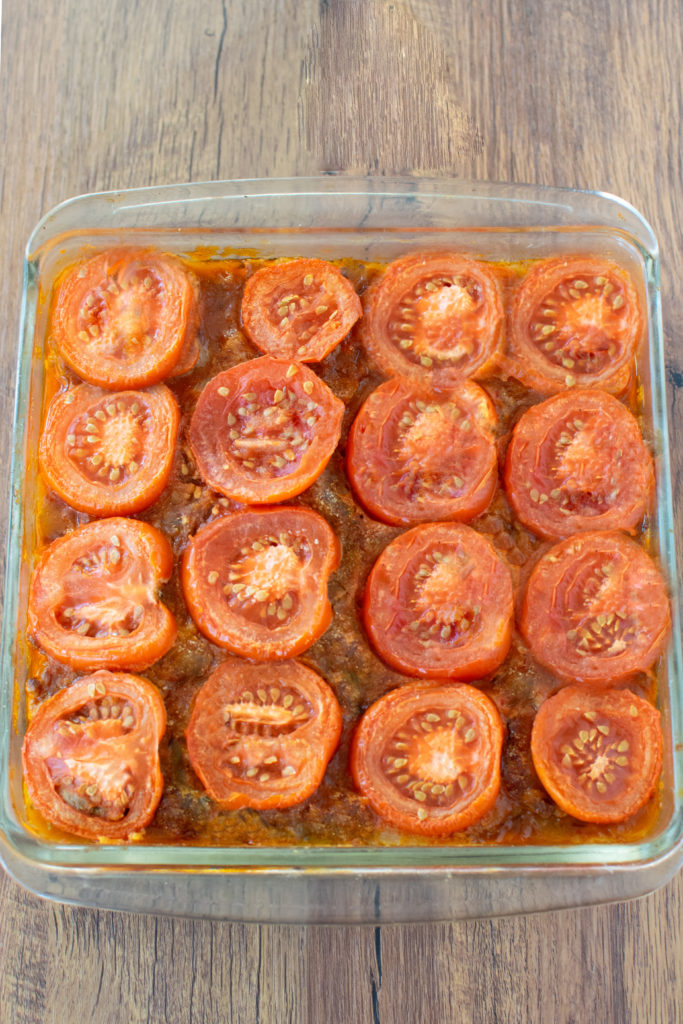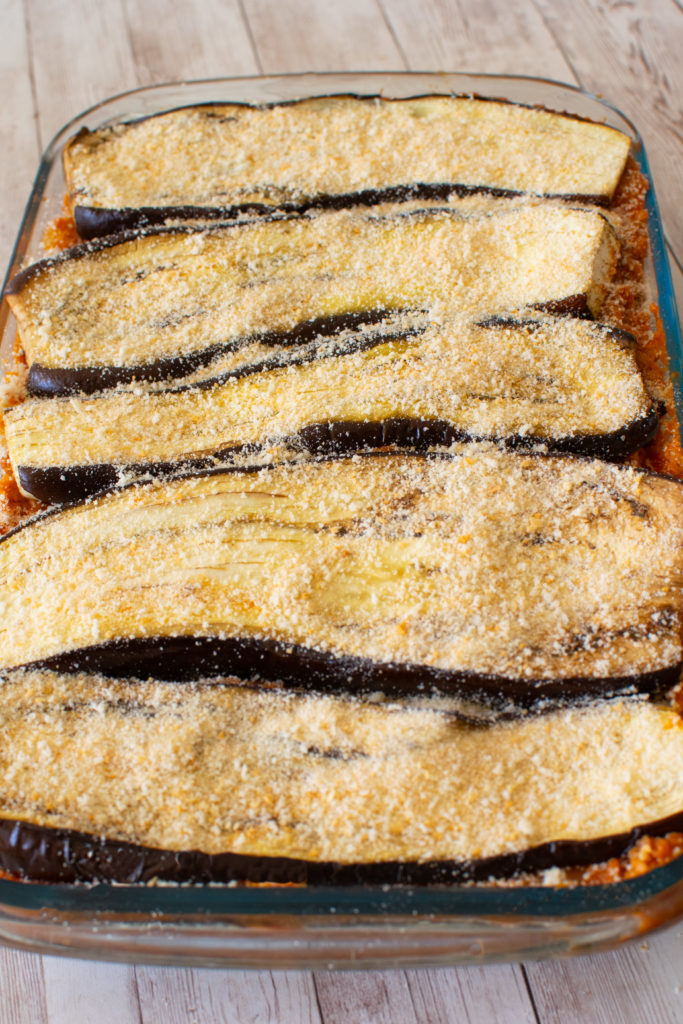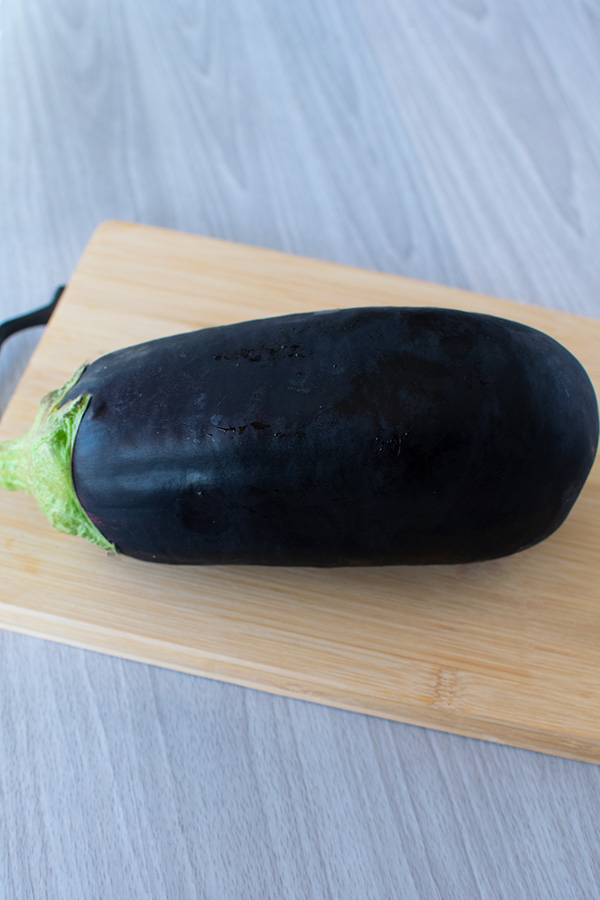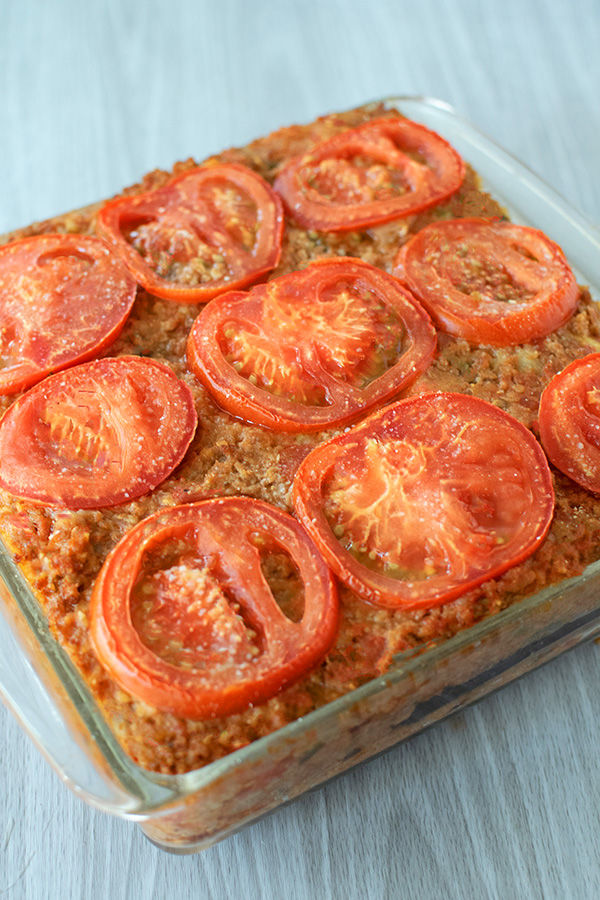Israeli Style Moussaka for Passover is made with layers of flavorful ground beef filling in between slices of eggplant and topped with slices of fresh tomato!

Moussaka is predominantly a Middle Eastern dish, each country with its own unique recipe and flavor. However, it is normally dairy. Israeli Style Moussaka for Passover is not only dairy-free, but it will surely become a Passover favorite!

A little of my cooking background
I really wanted to title this blog “If I can make it, anyone can” because, honestly, if I can make it, anyone can.
I never really liked cooking, and when I was single, a meal for me meant grilled cheese, eggs, tuna, or something else that didn’t require effort or time.
When my kids were young, I was still able to get away with preparing only a small variety of easy meals, but the older they got, the more dishes I learned to make at their request.
Still, I insisted on keeping it simple.
Honestly, I never understood why some cooks unnecessarily complicate meals. I have seen recipes that have several ingredients that don’t really seem to add much, if anything, to the dish. So, why bother?
It has always been important to me that whoever eats at my table will have plenty to enjoy, and that includes my kids (I never agreed with the “You will eat what is served or you won’t eat” ideology), and, because I keep it simple, I can prepare a variety of dishes in a relatively short period of time.
I have a philosophy regarding being a great cook: Prepare food according to the tastes of those who will be eating it, and they will love your cooking!
As far as I am concerned, start with the basic ingredients that make the dish what it is, adapt according to taste, and voila! You are an amazing cook!
The bottom line is that while there are certainly delicate recipes out there for specialty dishes, making delicious meals doesn’t have to be complicated or time-consuming. It’s not difficult to impress—just make sure it tastes good.
While some of the recipes on my blog are more time-consuming than others, they are all tried and true easy-shmeezy!
Of course, one always has to consider the conditions under which they cook. Weather (humidity, heat, cold), different types of ovens, different quality of pots, etc.—all of which can affect your cooking and baking.
Nevertheless, as I said, if I can do it, anyone can!
Food on Passover
Torah-observant Jews do not eat chametz (the fermented products of five grains: wheat, spelt, barley, oats, and rye).
In addition, Torah-observant Ashkenazi Jews do not eat kitniyot (or kitniyos as pronouced in Ashkenazi Hebrew). These include legumes, corn, rice, and similar foods that were deemed forbidden to eat by rabbis in the medieval period and are still not eaten today. Sephardi and Mizrachi Jews do not follow this tradition.
Many ovservant Ashkenazi Jews will not even eat the derivatives of these kitniyot, while others do (each family holds their own traditions regarding this).
Then, there are Ashkenazim who don’t eat “gebrokts” (or gebrochts).
Gebrokts means “broken” in Yiddish, and in this case refers to matzo that has absorbed liquid. Not eating gebrochts is observed by many in the Hasidic Jewish community and Ashkenazim who have taken on this tradition where they basically don’t mix anything wet with matzo.
So, things like matzo sandwhiches, fried matzo, and even matzo balls are a no-no for them.
There is a joke that sums it all up:
On Passover, we should remember people who have little to eat on this holiday. They are called Ashkenazim.
Over the years, I have learned to adapt “normal” food for passover so that my family won’t complain about boring, tasteless, or repetitive meals.
I find that having good food and variety makes the week of Passover a very pleasant experience and I hope this recipe will help make yours just that!

A little about Moussaka
Moussaka is an eggplant dish that is made in various places in the Middle East and the Mediterranean.
The most well-known type of moussaka internationally is the Greek version, which normally includes 3 layers.
The bottom layer is slices of eggplant fried in olive oil. On top of that is the meat – ground lamb (or beef) with onion, garlic, crushed tomatoes, herbs and spices. Then the meat is topped with cheese in Greek bechamel sauce.
The layers are place in a greased baking pan or dish, and baked until the top is a golden brown (which doesn’t take long at all as the bottom two layers were already cooked).
Other Mediterranean countries use different sauces or may sprinkle grated cheese or breadcrumbs.
The Turkish version includes fried eggplant, green peppers, tomatoes, onions, and ground beef and is not served in layers.
There are also versions that use zucchini, carrots, and potatoes. In fact, in places such as Bulgaria, Serbia, Bosnia, and others, potatoes are used instead of eggplant.
In Arab countries, moussaka is a cooked salad with the main ingredients being eggplant and tomatoes and is mostly served cold as an appetizer (moussaka = chilled).
Those are generalities and everyone kind of does there own thing when preparing this dish. This particularly holds true in Israel were one can find recipes that vary in ingredients (include various herbs and spices and may include both eggplant and potatoes).
Israeli Style Moussaka for Passover is not only kosher for Passover, but also one of the simplest non-dairy versions out there.
A little about Israeli cuisine
Some people complain about cultural appropriation in cuisine when food from one country is attributed to another country.
However, national cuisine in itself is often a mingling of food from of a variety of cultures, often due to a change of ruling countries and a shifting of borders.
Turkish cuisine, for example, goes back to the Ottoman Empire and was a combination of several cultures under Ottoman rule.
When people move from country to country, they will take their cultures with them and their decendents may adapt their traditional cuisine with that of their new home and, if they don’t, others might.
Chinese food in US restaurants is quite often not really authentic Chinese, but American Chinese.
Americans have created a whole variety of types and styles of pizza and pineapple pizza was apparently created in Canada by a Greek immigrant. Yet, everyone still calls them all “pizza”, which originated in Italy.
Spaghetti is thought to be an Italian food, but many historians believe that it was brought back to Italy from China by Marco Polo.
Apparently, battered fried fish was from the Portuguese Jewish community as a sabbath food and ended up in England via Holland during the Spanish Inquisition, yet everyone attributes the food to the British.
…and don’t get me started on Hummus.
When one lives in a melting pot, such as the US or Israel, it is just unrealistic to expect that food from a particular culture won’t mingle with that of other cultures.
That being said, “Israeli cuisine” is basically Middle Eastern (as opposed to Eastern European food) that was brought to Israel by Jews when they fled or were expelled from Muslim countries and moved to Israel mostly after the declaration of the State of Israel (collectively known as Mizrahi Jews).
Recipes were passed from generation to generation and, although decades have passed, the foods are still known by the culture they came from and everyone seems to have their own way of making them.
That said, there are many variations of pretty much any “Israeli” recipe, because of background, custom, or even just taste. When choosing a recipe, one has to know what actually constitutes a main ingredient – what makes the dish what it is – and what is left up to individual taste.
I personally find it very arrogant and quite irritating when a blogger(not naming names) will put “authentic” in the title of an “Israeli” recipe, as if all the rest are mere imitations. What’s worse, is when that blogger makes the recipe with her own twist and then calls it authentic!
Adding more or less of a spice or adding a spice that is not in the recipe, does not make it less authentic, but calling it “authentic” and then adding unnecessary extra ingredients above and beyond what needs to be there, is misleading.
For example, “authentic” Israeli salad (what Israelis call Israeli salad) is diced tomatoes and cucumbers. Sometimes, they will add some oil salt and pepper, but THAT’S IT. Anything else does not have to be there, but if you leave out the cucumbers or the tomatoes, you no longer have an “Israeli salad”.
So, find the recipes you like with the ingredients you prefer, add your own twists, and בתאבון (literally translated, “with appetite”) !
A little about eggplants
The eggplant is native to India and Asia, where it can be found growing wild and it is believed that eggplants were brought to Europe sometime during the 7th or 8th century.
Australians and Americans call the vegetable eggplant, while in England it is called a aubergine from the French word for this vegetable.
Because of it’s meaty texture, eggplant is used instead of meat in some vegetarian versions of meat recipes.
While there are a variety of types of eggplants, the one for this recipe is the large egg-shaped (or teardrop-shaped) blackish purple one with the meaty inside.

Eggplants have health benefits as they contain antioxidants like vitamins A and C, which help protect your cells against damage and are low in calories.
About cooking eggplant
Eggplants can be roasted, baked, steamed, deep fried, or sautéd.
Before cooking an eggplant, cut off the top part where the green is (called a calyx). The bottom tip should also be removed, but this is not imperative. The skin is perfectly fine to eat, but it must be cooked well, otherwise it may come out chewy.
This recipe can use either peeled eggplants or with the skin (having the skin on will not ruin the recipe).
Eggplant is naturally a little bitter. If you find that to be the case, you can draw out the bitterness by sprinkling it with salt and let it sit a while. If you are using slices or pieces, slightly salt after cutting. I have personally never found this to be a problem when cooking with eggplants
Using salt before cooking can help prevent the eggplant from absorbing too much oil and becoming greasy if using oil with the eggplant recipe (I normally just pat the pieces with a paper towel if need be).
If you do use salt, MAKE SURE to rinse it off before cooking the eggplant or the salt will become a part of your dish!
Personally, I have never salted my eggplants before using them (and I have used eggplants in two countries) and have never had any problem with bitterness, but if you have any concern, please do.
If a recipe calls for frying, but you prefer not to do so because of the calories the oil will add to the recipe, you can spray with cooking oil and bake instead.
Kosher for Passover Pantry Essentials (Suggestion)
As I learned to prepare more and more recipes for Passover, I also learned which basics and seasonings are good to have on hand to have the ability to make a dish on short notice—especially during the holiday—and not have to run out to the store or borrow from a neighbor.
While I will admit that I am not always prepared when one of my kids will ask for eggplant parmesan or something at the drop of a hat (which they have done), I dislike having to postpone making something just because the ingredients needed to make a reasonable meal were not readily available.
So, I maintain a selection of what I consider “kosher for Passover pantry essentials” in my refrigerator and on my shelves during the week of Passover (some of the dry goods, I keep from year to year, stored well).
While, of course, most of the essentials will not be needed just for any one recipe, at least some of them are needed for most recipes, and you would be surprised how many recipes can be made just with this list. So, if you make sure to have whatever you use regularly on hand, it can really save you time and effort.
Everyone has their favorite recipes, preferred seasoning, and just whatever they like to use to cook. Your own list should certainly reflect your own cooking tastes and style. Just make sure that everything is Kosher for Passover (KLP) and if you are Ashkenazi, that list will be shorter than if you are not.
Make sure to check with a qualified rabbi if you have any questions.
Following is a pretty comprehensive list of what you can choose from to keep on hand. I keep quite a bit of it.
Seasoning and flavoring:
- salt
- ground black or white pepper
- granulated garlic or garlic powder
- onion powder
- ground cinnamon
- sugar (granulated)
- brown sugar
- chicken consomme powder
- onion soup mix
- various herbs
- additional spices to adapt taste to preference
Misc:
- oil / margarine / butter / cooking spray
- potato starch as a thickening agent
- baking powder
- matzo cake meal (matzo meal, but ground into a powder)
- condiments, such as ketchup and barbecue sauce
- tomato sauce/tomato paste/canned tomatoes—diced or crushed/pasta sauce
- milk substitute (neutral flavor)
We always have eggs in the fridge and onions, and potatoes on our shelves (if we were not Ashkenazi, I would certainly keep rice as well).
In addition, having some fresh vegetables in the fridge, such as carrots, celery, tomatoes, bell peppers (red, green, etc), etc. can be very useful when putting together a quick, but delicious meal.
It is also a good idea to have some ground meat or chicken (breast, ground, or in parts), in the freezer for anyone who likes meat dishes in a snap.
Why are these pantry essentials beneficial to have on hand?
Personally, having the above ingredients in my kitchen is very advantageous, as I make a variety of dishes and use most of the items on the list regularly.
Whether or not buying a bunch of herbs, spices, etc. before you know what you are going to make for the week is workable for you depends on your own personal preference.
Of course, the more you cook and the more varied your recipes, the more you will use, and the more you will need.
If you plan your meals ahead for the week, you will be prepared with whatever else you might need that you wouldn’t even normally keep in your passover pantry.
If you do decide to keep them over from year to year, I would only do so if they can be sealed well (or better yet, stored in the freezer), because not only can weather have an affect on some of the spices and on the chicken consommé powder, but you will be surprised to know just how clever moths are at getting into sealed bags and how hot red pepper powder can attract little black bugs – YUCK!
Dairy Free Israeli Moussaka for Passover

Moussaka, Israeli style, for Passover
Ingredients
- 2 medium eggplants (approximately 9 inches long)
- 1 medium onion dice or chopped
- 2-3 celery stalks diced or chopped very small
- 1 - 28oz can diced tomatoes or equivalent, drained, kosher for Passover
- 1 1/2 pounds ground beef (or other ground meat)
- 2 tbsp chicken consomme powder or beef bullion powder, kosher for Passover
- 1 tablespoon white granulated sugar
- 1/4 cup tomato paste, kosher for Passover
- 1/2 tsp black pepper
- 1 cup matza cake meal
- 1 - 2 tomatoes, sliced
- oil for frying
Instructions
Eggplant
- Sliced eggplant lengthwise into 6 slices each (you should have a total of 12 slices).
- Place evenly on baking sheet covered with baking paper and lightly spray with cooking spray.
- Place in a preheated oven at 400° F for 20 - 40 minutes (or lightly fry) until slices have softened, slightly dehydrated, and browned a little.
- Let cool.
Meat Mixture
- Pour enough oil into a large saucepan to just cover the bottom.
- On medium heat, saute diced onions and celery until mostly clear.
- Add diced tomatoes, ground beef, chicken consomme powder, tomato paste, and pepper.
- Mix well and cook on medium heat until meat and tomatoes are thoroughly cooked.
- Add matza cake meal a little at a time and mix until the liquid has completely soaked up.
Prepring the dish
- Lay three slices of eggplant on the bottom of a 9" x 9" baking pan
- Cover with a layer of the meat mixture, then another layer of eggplant. Repeat until the eggplant and meat mixture are done (if you use 3 slices of eggplant per layer, then you will use 1/4 of the meat mixture in between each layer and if you use 4 slices of eggplant per layer, then you will use 1/3 of the meat mixture in between each layer.
- Cover the top with slices of tomato and sprinkle a little matza cake meal on top (optional).
- Bake at 400° for approximately 20 - 30 minutes or until the tomato on top is cooked.
Notes
* Kosher for Passover
Nutrition Information:
Yield:
9Serving Size:
1Amount Per Serving: Calories: 404Total Fat: 20gSaturated Fat: 6gTrans Fat: 1gUnsaturated Fat: 12gCholesterol: 88mgSodium: 257mgCarbohydrates: 34gFiber: 6gSugar: 20gProtein: 24g